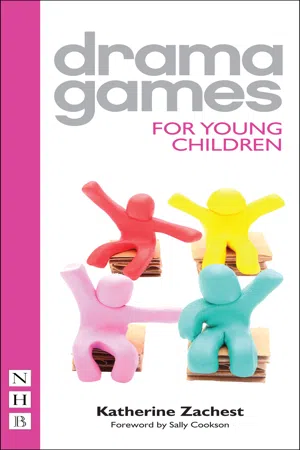![]()
1. Let’s Get Started!
This lesson helps to establish dramatic rules and conventions – including the freeze rule and the importance of discussion – and helps the children to understand the way a drama class runs. I’d recommend you start with this lesson. Children explore using their body and voices to express emotions.
Resources
•Music to dance to.
WARM-UP
Warm-up Circle
Make a circle with the children holding hands. Let the children know that they should not fall over, pull anyone’s arms or run. Once the students have formed a circle, proceed as follows:
•Let’s take little steps in, in, in. Look how small our circle is!
•Let’s take big steps back, back, back. Look at how big our circle is!
•Remember, don’t pull our friend’s arms.
•Let’s take little steps in, in, in. Let’s say ‘hello’.
•Let’s take big steps back, back, back.
•One more time, coming in, in, in. Hello!
•And back, back, back.
•Let’s let go of each other’s hands.
•Stretch up as tall as you can.
•And now move down as small as you can.
•And now can you make yourself stretch out wide. Stretch your fingers out as well and reach to either side of the room.
•Good, and now can you cross your arms and give yourself a big hug? Squeeze tightly.
The Freeze Rule
Ask the children to remain standing in a circle. Once the children are settled, proceed as follows:
•I’m going to see how clever you are at being a statue.
•In a moment, I will ask you to wiggle your whole body, but when I call ‘freeze’, you have to be as still and as quiet as a statue.
•Ready? GO!
Allow the children to wiggle their bodies for a count of five.
•Freeze! Wow, look at these amazing statues. But I think I saw a little wiggle over here. Let’s try again, ready, GO!
Allow the children to move again.
•Freeze! Wow, I can’t believe how still you are. You are all very good at this.
•I am going to have to make it harder for you. This time let’s walk around the space. We are going to stay on this mat (or another designated area, but keep it small so you maintain control and focus of the children).
•As you are moving around, there is no running and no touching anybody else. Be ready to freeze.
Allow the children five counts to move around before calling ‘freeze’. Compliment good statues and no sound.
•Good, walking around again. This time when you freeze, can you freeze with your hands on your hips? Ready? Freeze.
•Good, walking around again. Now this time when you freeze can you put your arms in the air?
Continue to get the children walking around and freezing in a specific statue. As they are walking, ask them to freeze as:
oa tall giraffe
oan apple with a stalk
oa bird with large wings
oa round ball
oa tree with big branches
oa cheeky monkey
You may also ask them to move differently. For example: they could try moving sideways, taking little or long steps, walking on tippy-toes or like a penguin.
Emotions
Ask the children to stand in a circle. When the children are settled, use the following instructions:
•Show me your hands. Let’s see if you can make your hands move in different ways.
•Can you make them move quickly?
•Can you make them move slowly?
•Can you make them look happy? (The hand ‘bounces’.)
•Good, now let’s make them look angry. (Tense, small shakes.)
•Good work, can you make them look shy? (Moves towards or behind the body.)
•And now let’s make them look excited. (Moves quickly.)
•We can make our hands look different. Now let’s try and make our bodies look different.
•Can you show me an angry statue? Good, now let’s move around like we are angry. Remember, no running or touching anybody else. We are just pretending to be angry. Show me hands on hips. Show me crossing your arms. Make your hands look angry, angry arms, angry feet. I am going to ask you to freeze as an angry statue.
•Ready? Freeze. Can you say, ‘I’m angry’? Excellent work.
•Take a big breath in and shake that one away.
•Now let’s see if we can pretend to be sad. Show me sad shoulders, sad arms, sad back, sad knees and even sad feet. We are going to make a sad statue.
•Ready? Freeze. Can you say, ‘I’m sad, boohoo’?
•And take a big breath in and blow that one away. Fantastic.
•Now let’s imagine we are confused. Show me your thinking face. Can you scratch your head? Walk around and then change direction. You are very confused. We are going to freeze in a confused statue.
•Ready? Freeze. Can you say, ‘I’m confused’?
•Good work, take a big breath in and blow that one away.
Continue exploring different emotions, such as excitement, boredom and fear.
Discuss
Ask the children to sit in a circle. When the children are settled, ask them to discuss what they know about drama. You may like to use the fol...
